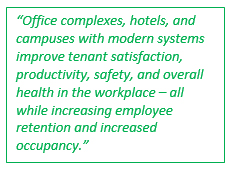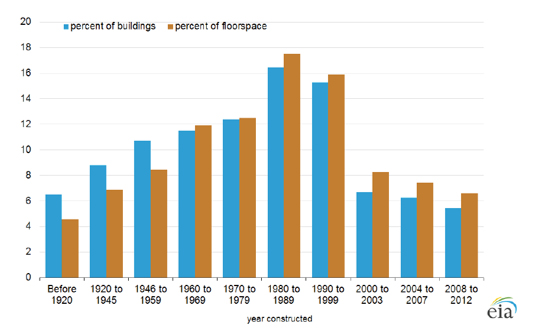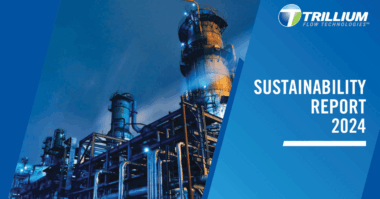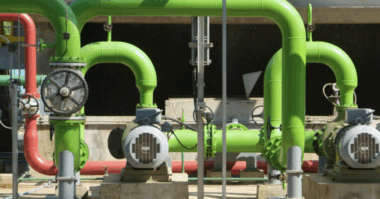Authors: Kurt Gokbudak, Systems Architect, Schneider Electric, and Jack Creamer, Market Segment Manager, Pumping Equipment–Industry Business, Schneider Electric
Tenants today – whether they are office workers, hotel guests, or students on a campus – demand all the conveniences of a smart, intelligent building, including modern connectivity and mobility, workplace quality, sustainability, security, and efficiency. With this kinds of capabilities, both tenants and owners benefit, as seen through improved tenant satisfaction, productivity, safety, and overall health in the workplace – as well as increased employee retention and occupancy rates.
For instance:
 Office workers want the same modern conveniences that connectivity offers them at home and elsewhere. They want always-on access for all their mobile devices, and they want to control their working environment to ensure the most productivity possible. In fact, according to Navigant Research, the fine tuning of lighting and HVAC settings in office buildings can not only generate cost savings, operational efficiency, and sustainability improvements, but it can also create a better occupant experience. And intelligent building solutions promote occupant health, which in turn drives greater productivity as a result of reduced absenteeism and greater satisfaction.1
Office workers want the same modern conveniences that connectivity offers them at home and elsewhere. They want always-on access for all their mobile devices, and they want to control their working environment to ensure the most productivity possible. In fact, according to Navigant Research, the fine tuning of lighting and HVAC settings in office buildings can not only generate cost savings, operational efficiency, and sustainability improvements, but it can also create a better occupant experience. And intelligent building solutions promote occupant health, which in turn drives greater productivity as a result of reduced absenteeism and greater satisfaction.1- Hotel guests want a personalized, connected, and intuitive digital experience that provides them with comfort, convenience and control. When hotels deliver this effectively, it can positively impact their future business. For instance, a 1% increase in online reputation score leads up to a 0.89% increase in average daily rates, an occupancy increase up to 0.54%, and up to a 1.42% increase in revenue per available room. 2
- On campuses, the connectivity, reliability, sustainability, and efficiency of classrooms, dormitories, recreation, dining, and athletic facilities are critical components in today’s competitive higher education environment. Student and faculty recruitment, national rankings and the overall welfare of the campus population are all impacted by the condition and usability of a school’s facilities. In fact, studies show students’ performance increased by an average of 15% and up to 30% with improvements such as better indoor climate control.
Office complexes, hotels, and campuses with modern capabilities also benefit building management, as updated systems are a foundation for better energy usage, improved maintenance, increased security, and more effective space utilization. They also drive improved financial performance and operational efficiency. In addition, they increase the ability for owners to offer competitive properties in a market where tenant demands are high and vacancy rates are the lowest they have been in years.
Future-proofing aging buildings with these kinds of capabilities can be challenging. Older buildings can’t support smart, intelligent technologies with existing, outdated systems. They need updated infrastructures that address tenant needs with up-to-date IT and communications technology as well as advanced energy management, mechanical, and space utilization systems.
This series explores how building owners and managers can update their facilities through the modernization of existing infrastructures, proactive maintenance, and updated technology systems. The article series also examines how innovative energy management and building management systems can help optimize facility performance.
According to the U.S. Energy Information Administration 2012 data, nearly half of all commercial buildings were constructed before 1980. 3
Similarly, data from SMR Research Corporation indicates that the average age of U.S. commercial buildings in the United States was 41.7 years in 2009. Add on the years between now and then, and the average age of the 4.61 million buildings in that study is now over 50 years old.
The age of buildings on higher education campuses is very similar. According to a Sightlines report, State of Facilities in Higher Education: 2014 Benchmarks, Best Practices, and Trends, 51% of all buildings on American college campuses were built between 1951 and 1990. 4
READ PART 2: COMMON ISSUES IN AGING BUILDINGS
Footnotes
1 Intelligent Buildings: 10 Trends to Watch in 2016 and Beyond, Navigant Research, 2016
2 The impact of social media on lodging performance, by Chris K. Anderson, PhD, Cornell Hospitality Reports, Nov. 2012; Vol. 12, Number 15, 6-11.
3 Commercial Buildings Energy Consumption Survey, U.S Energy Information Administration, 2012
4 State of Facilities in Higher Education, Sightlines, 2014
About the Authors
Kurt Gokbudak is a systems architect for Schneider Electric. He focuses on understanding the energy and operational challenges and needs that facilities face today so Schneider Electric can provide the best tools to address them and better position these facilities for the future. He has been with Schneider Electric for 5 years and has held sales, marketing, and operational positions throughout his 25-year career. He is a Certified Energy Manager (CEM) and is an active member of the Association of Engineers (AEE) and the American Society of Heating, Refrigerating, and Air-Conditioning Engineers (ASHRAE). He holds a bachelor’s degree in mechanical engineering from the University of Illinois.
Jack Creamer is Schneider Electric Segment Marketing Manager – Pumping Equipment, based in the United States. Mr. Creamer has more than 30 years in the Electrical Industry, and has been involved for 10 years in the Pumping Industry. He is involved in key industry organizations such as the Hydraulic Institute and Submersible Wastewater Pump Association, where he holds both Committee Chair and Board level positions. In his time in the Pump industry, he has help Schneider create numerous solutions that both enhance pumping efficiency and address issues such as maintenance and downtime.






